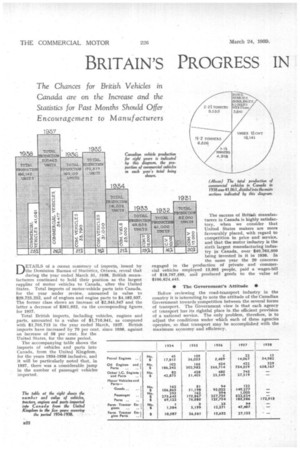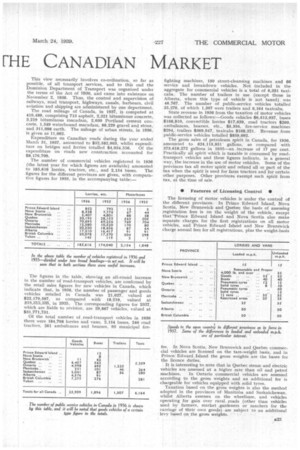BRITAIN'S PROGRESS IN FHE CANADIAN MARKET
Page 48

Page 49

If you've noticed an error in this article please click here to report it so we can fix it.
The Chances for British Vehicles in Canada are on the Increase and the Statistics for Past Months Should Offer Encouragement to Manufacturers DETAILS of a recent summary of imports, issued by the Dominion Bureau of Statistics, Ottawa, reveal that during the year ended March 31, 1938, British manufacturers continued to hold their position as the largest supplier of motor vehicles to Canada, after the United States. Total imports of motor-vehicle parts into Canada, for the year under review, amounted in value to $29,725,252, and of engines and engine parts to $4,182,937. The former class shows an increase of $2,345,547 and the latter a decrease of $361,952, on the corresponding figures. for 1937.
Total British imports, including vehicles, engines and parts, amounted to a value of $1,710,941, as compared with $1,705,713 in the year ended March, 1937. British imports have increased by 70 per cent. since 1936, against an increase of 58 per cent, for the United States, for the same period.
The accompanying table shows the imports of vehicles and parts into Canada, from the United Kingdom, for the years 1934-1938 inclusive, and it will be particularly noted that, in 1937, there was a considerable jump in the number of passenger vehicles-. imported. The success of British Manufacturers in Canada is highly satisfactory, when we consider that United States makers are more 0 favourably placed, with regard to o competition in price and service, o and that the motor industry is the u sixth largest manufacturing indus try in Canada, over $40,765,000 being invested in it in 1936. in the same year the 20 concerns engaged in the production of private and commercial vehicles employed 13,095 people, paid a wages-bill of $18,797,599, and produced goods to the value of $106,624,445. 2076
• The Government's Attitude •
Before reviewing the road-transport industry in the country it is interesting to note the attitude of the Canadian Government towards competition between the several forms of transport. The Government view is that each agency of transport has its rightful place in the efficient provision of a national service. The only problem, therefore, is to adjust the conditions under which each of these agencies operates, so that transport may be accomplished with the maximum economy and efficiency. This view necessarily involves co-ordination, so far as possible, of all transport services, and to this end the Dominion Department of Transport was organized under the terms of the Act of 1936, and came into existence on November 2, 1936, Thus, the control and supervision of railways, road transport, highways, canals, harbours, civil aviation and shipping are administered by one department.
The road mileage of Canada, in 1937, is computed at 410,488, comprising 713 asphalt, 2,321 bituminous concrete, 3,219 bituminous macadam, 2,030 Portland cement concrete, 1,549 waterbound macadam, 88,229 gravel and stone, and 311,098 earth. The mileage of urban streets, in 1936, is given as 11,662.
Expenditure on Canadian roads during the year ended March 31, 1937, amounted to $52,582,903, whilst expendi ture on bridges and ferries totalled $4,934,556. Of the expenditure on roads new construction accounted for $8,176,709.
The number of commercial vehicles registered in 1936 (the latest year for which figures are available) amounted to 185,616 lorries, tractors, etc., and 2,154 buses. The figures for the different provinces are given, with comparative figures for 1935, in the accompanying table: The figures in the table, showing an all-round increase in the number of road-transport vehicles, are confirmed by the retail sales figures for new vehicles in Canada, which indicate that, in 1936, the number of passenger and goods vehicles retailed in Canada was 21,027, valued at $22,179,597, as compared with 18,219, valued at &118,313,335, in 1935. The corresponding figures for 1937, which are liable to revision, are 29,867 vehicles, valued at $31,771,731.
Of the total number of road-transport vehicles in 1936 there were 184,798 lorries and vans, 2,154 buses, 246 road tractors, 261 ambulances and hearses, 95 municipal fire fighting machines, 150 street-cleansing machines and 66 service and breakdown vehicles. Not included in the aggregate for commercial vehicles is a total of 6,331 taxicabs. The number of trailers in use (except those in Alberta, where this type of vehicle is not taxed) was 46,767. The number of public-service vehicles totalled 35,276, of which 1,307 were trailers and 6,164 taxicabs.
State revenue in 1936 from the taxation of motor vehicles was collected as follows:-Goods vehicles $6,613,937, buses $168,810, convertible lorries $17,639, road tractors $260, ambulances, hearses. etc., $5,334, fire-service machines $294, trailers $369,947, taxicabs $168,321. Revenue from public-service vehicles totalled $859,692.
The gross sales of petroleum spirit in Canada, for 1936, amounted to 624,115,851 ' gallons, as compared with 573,618,272 gallons in 1935-an increase of 17 per cent. Practically all spirit which is taxable is consumed by roadtransport vehicles and these figures indicate, in a general way, the increase in the use of motor vehicles. Some of the provinces tax all motor spirit and refund all or part of the tax when the spirit is used for farm tractors and for certain other purposes. Other provinces exempt such spirit from tax, at the time of sale.
• Features of Licensing Control •
The licensing of motor vehicles is under the control of the different provinces. In Prince Edward Island, Nova Scotia, New Brunswick and Quebec the basis of assessing registration fees is on the weight of the vehicle, except that 'PrinceEdward Island and Nova Scotia also make separate charges for the first registrations on all motor vehicles, and Prince Edward Island and New Brunswick charge annual fees for all registrations, plus the weight-basis fee. In Nova Scotia, New Brunswick and Quebec commercial vehicles are licensed on the tare-weight basis, and in Prince Edward Island the gross weights are the bases for the licence duties.
It is interesting to note that in Quebec steam and electric vehicles are assessed at a higher rate than oil and petrol machines. In Ontario commercial vehicles are assessed according to the gross weights and an additional fee is chargeable for vehicles equipped with solid tyres.
Taxation based on the gross weights is also the method adopted in the provinces of Manitoba and Saskatchewan, whilst Alberta assesses on the wheelbase, and vehicles operating for gain over rural roads (other than vehicles used by farmers, market gardeners or ranchers for the carriage of their own goods) are subject to an additional levy based on the gross weights.




















































































